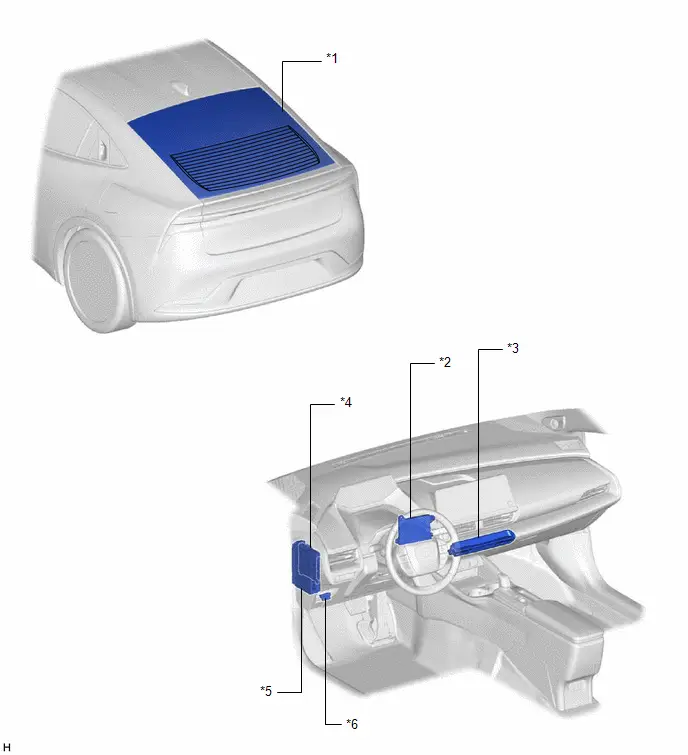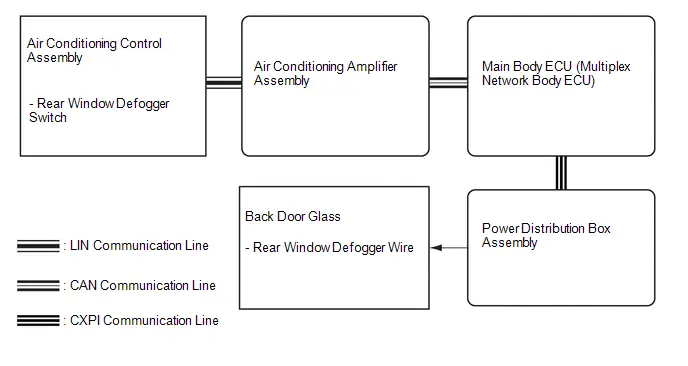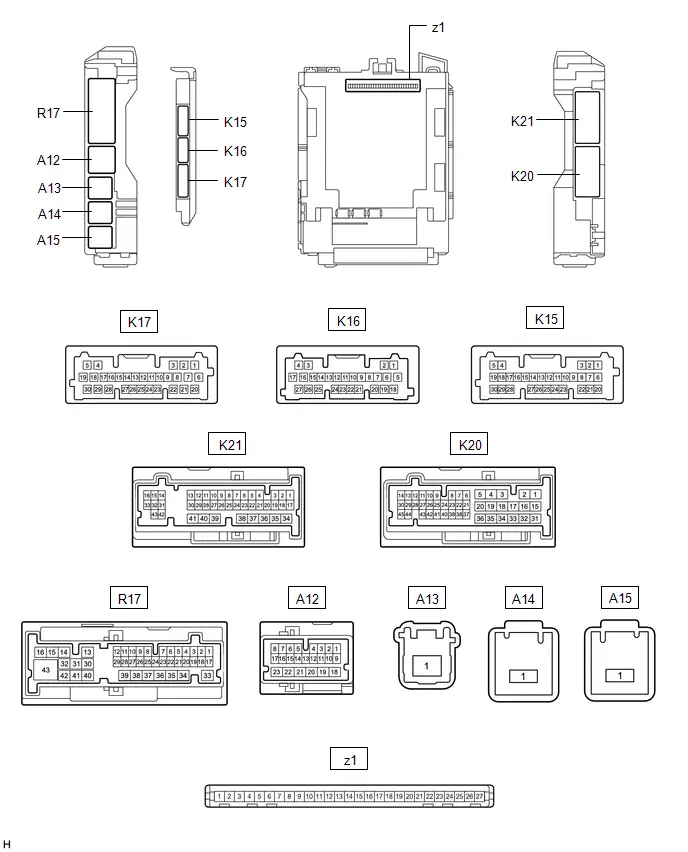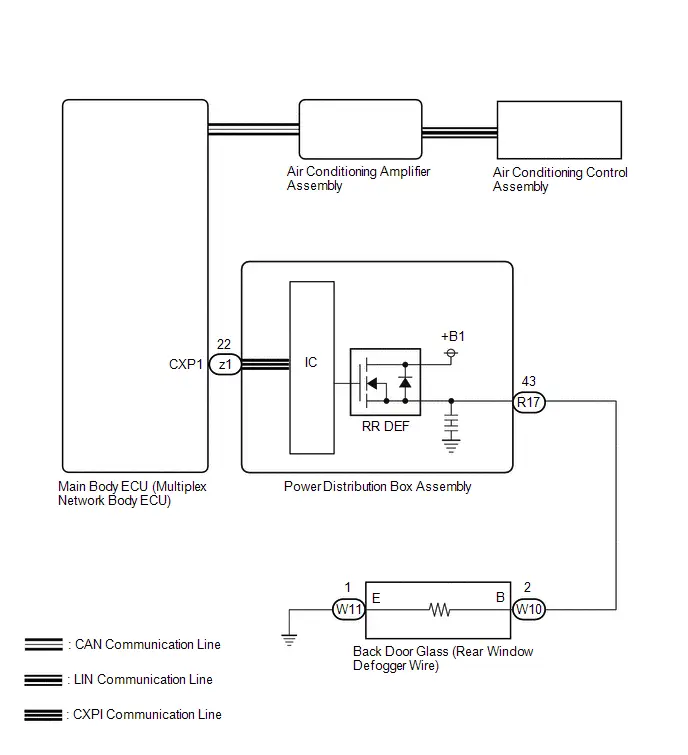Toyota Prius: Window Defogger System
- Precaution
- Parts Location
- System Diagram
- How To Proceed With Troubleshooting
- Operation Check
- Problem Symptoms Table
- Terminals Of Ecu
- Data List / Active Test
- Rear Window Defogger System does not Operate
Precaution
PRECAUTION
PRECAUTIONS FOR DISCONNECTING CABLE FROM NEGATIVE (-) AUXILIARY BATTERY TERMINAL
NOTICE:
After the ignition switch is turned off, there may be a waiting time before disconnecting the negative (-) auxiliary battery terminal.
Click here

HINT:
When disconnecting and reconnecting the auxiliary battery, there is an automatic learning function that completes learning when the respective system is used.
Click here


Parts Location
PARTS LOCATION
ILLUSTRATION

| *1 | BACK DOOR GLASS - REAR WINDOW DEFOGGER WIRE | *2 | AIR CONDITIONING AMPLIFIER ASSEMBLY |
| *3 | AIR CONDITIONING CONTROL ASSEMBLY - REAR WINDOW DEFOGGER SWITCH | *4 | MAIN BODY ECU (MULTIPLEX NETWORK BODY ECU) |
| *5 | POWER DISTRIBUTION BOX ASSEMBLY | *6 | DLC3 |
System Diagram
SYSTEM DIAGRAM

How To Proceed With Troubleshooting
CAUTION / NOTICE / HINT
HINT:
- Use the following procedure to troubleshoot the window defogger system.
- *: Use the GTS.
PROCEDURE
| 1. | Toyota Prius Vehicle BROUGHT TO WORKSHOP |
|
| 2. | CUSTOMER PROBLEM ANALYSIS |
HINT:
- In troubleshooting, confirm that the problem symptoms have been accurately identified. Preconceptions should be discarded in order to make an accurate judgment. To clearly understand what the problem symptoms are, it is extremely important to ask the customer about the problem and the conditions at the time the malfunction occurred.
- Gather as much information as possible for reference. Past problems that seem unrelated may also help in some cases.
-
The following 5 items are important points for problem analysis:
What
Toyota Prius Vehicle model, system name
When
Date, time, occurrence frequency
Where
Road conditions
Under what conditions?
Driving conditions, weather conditions
How did it happen?
Problem symptoms
|
| 3. | PRE-CHECK |
(a) Measure the auxiliary battery voltage with the ignition switch off.
Standard Voltage:
11 to 14 V
If the voltage is below 11 V, recharge or replace the auxiliary battery before proceeding to the next step.
(b) Check the fuses and relays.
(c) Check the connector connections and terminals to make sure that there are no abnormalities such as loose connections, deformation, etc.
(d) Check the Toyota Prius vehicle specifications.
|
| 4. | INSPECT COMMUNICATION FUNCTION OF CAN COMMUNICATION SYSTEM* |
(a) Using the GTS, check for CAN communication system DTCs.
for HEV Model: Click here

for PHEV Model: Click here

| Result | Proceed to |
|---|---|
| CAN DTCs are not output | A |
| CAN DTCs are output | B |
| B |

| GO TO CAN COMMUNICATION SYSTEM for HEV Model: Click here
for PHEV Model: Click here
|
|
| 5. | INSPECT COMMUNICATION FUNCTION OF CXPI COMMUNICATION SYSTEM* |
(a) Using the GTS, check for CXPI communication system DTCs.
| Result | Proceed to |
|---|---|
| CXPI DTCs are not output | A |
| CXPI DTCs are output | B |
| B |

| GO TO CXPI COMMUNICATION SYSTEM |
|
| 6. | PROBLEM SYMPTOMS TABLE |
(a) Refer to Problem Symptoms Table.
Click here

| Result | Proceed to |
|---|---|
| Fault is not listed in Problem Symptoms Table | A |
| Fault is listed in Problem Symptoms Table | B |
| B |

| GO TO STEP 8 |
|
| 7. | OVERALL ANALYSIS AND TROUBLESHOOTING* |
(a) Operation Check
Click here

(b) Terminals of ECU
Click here

(c) Data List / Active Test
Click here

|
| 8. | REPAIR OR REPLACE |
|
| 9. | CONFIRMATION TEST |
| NEXT |

| END |
Operation Check
OPERATION CHECK
CHECK WINDOW DEFOGGER SYSTEM
NOTICE:
If the window defogger system is operated when the auxiliary battery voltage is low, due to the electrical load limit control that gives voltage supply priority to the power steering system, the window defogger system may not operate. In this case, check the Toyota Prius vehicle control history (RoB) of the power steering system and check that "Battery Voltage Drop: X208F" is not stored before proceeding with troubleshooting.
Click here

(a) Turn the ignition switch to ON.
(b) Check that the rear window defogger wire becomes warm by operating the rear window defogger switch of the air conditioning control assembly.
(c) When the Toyota Prius vehicle is stopped, confirm that the window defogger system operation stops after approximately 15 minutes.
Problem Symptoms Table
PROBLEM SYMPTOMS TABLE
NOTICE:
If the window defogger system is operated when the auxiliary battery voltage is low, due to the electrical load limit control that gives voltage supply priority to the power steering system, the window defogger system may not operate. In this case, check the Toyota Prius vehicle control history (RoB) of the power steering system and check that "Battery Voltage Drop: X208F" is not stored before proceeding with troubleshooting.
Click here

HINT:
Use the table below to help determine the cause of problem symptoms. If multiple suspected areas are listed, the potential causes of the symptoms are listed in order of probability in the "Suspected Area" column of the table. Check each symptom by checking the suspected areas in the order they are listed. Replace parts as necessary.
Window Defogger System| Symptom | Suspected Area | Link |
|---|---|---|
| Window defogger system does not operate | Proceed to the "Rear Window Defogger System does not Operate" |
|
Terminals Of Ecu
TERMINALS OF ECU
CHECK POWER DISTRIBUTION BOX ASSEMBLY

(a) Measure the voltage according to the value (s) in the table below.
| Tester Connection | Terminal Description | Condition | Specified Condition |
|---|---|---|---|
| R17-43 - Body ground | Rear window defogger signal (output) | Rear window defogger switch off | Below 1 V |
| Rear window defogger switch on | 11 to 14 V |
CHECK AIR CONDITIONING AMPLIFIER ASSEMBLY, AIR CONDITIONING CONTROL ASSEMBLY
for HEV Model: Click here

for PHEV Model: Click here

Data List / Active Test
DATA LIST / ACTIVE TEST
DATA LIST
NOTICE:
In the following table, the values listed under "Normal Condition" are reference values. Do not depend solely on these reference values when deciding whether a part is faulty or not.
HINT:
Using the GTS to read the Data List allows the values or states of switches, sensors, actuators and other items to be read without removing any parts. This non-intrusive inspection can be very useful because intermittent conditions or signals may be discovered before parts or wiring is disturbed. Reading the Data List information early in troubleshooting is one way to save diagnostic time.
(a) Read the Data List according to the display on the GTS.
Body Electrical > Power Distribution Box > Data List| Tester Display | Measurement Item | Range | Normal Condition | Diagnostic Note |
|---|---|---|---|---|
| Rear Defogger Input Signal | Window defogger switch signal input condition | OFF or ON | OFF: Window defogger switch is off ON: Window defogger switch is on | - |
| Rear Defogger Output Signal | Window defogger output condition | OFF or ON | OFF: Window defogger does not operate ON: Window defogger operates | - |
| Rear Defogger Output Current | Window defogger current | Min.: 0, Max.: 255 A | Current window defogger current displayed | Window defogger current when output is on |
| Rear Defogger Fuse Shut Off Status | Window defogger fuse condition | OFF or ON | OFF: Fuse shut off ON: Fuse not shut off | - |
| Rear Defogger Fuse Shut Off Count | Window defogger fuse shut off times | Min.: 0, Max.: 255 Times | 0 Times | - |
| Tester Display | Measurement Item | Range | Normal Condition | Diagnostic Note |
|---|---|---|---|---|
| Rear Defogger Relay | Window defogger operation condition | OFF or ON | OFF: Window defogger does not operate ON: Window defogger operates | - |
ACTIVE TEST
HINT:
Using the GTS to perform Active Tests allows relays, VSVs, actuators and other items to be operated without removing any parts. This non-intrusive functional inspection can be very useful because intermittent operation may be discovered before parts or wiring is disturbed. Performing Active Tests early in troubleshooting is one way to save diagnostic time. Data List information can be displayed while performing Active Tests.
(a) Perform the Active Test according to the display on the GTS.
Body Electrical > Air Conditioner > Active Test| Tester Display | Measurement Item | Control Range | Diagnostic Note |
|---|---|---|---|
| Rear Defogger Relay | Rear window defogger wire | OFF or ON | - |
Rear Window Defogger System does not Operate
DESCRIPTION
When the rear defogger switch on the air conditioning control assembly is operated, an operation request signal is sent to the air conditioning amplifier assembly via CAN communication. When the air conditioning amplifier assembly receives an operation request signal, an operation request signal is sent to the main body ECU (multiplex network body ECU) via CAN communication. The main body ECU (multiplex network body ECU) turns on the RR DEF relay through the IC of the power distribution box assembly and the window defogger operates.
WIRING DIAGRAM

CAUTION / NOTICE / HINT
NOTICE:
-
If the window defogger system is operated when the auxiliary battery voltage is low, due to the electrical load limit control that gives voltage supply priority to the power steering system, the window defogger system may not operate. In this case, check the Toyota Prius vehicle control history (RoB) of the power steering system and check that "Battery Voltage Drop: X208F" is not stored before proceeding with troubleshooting.
Click here

-
The window defogger system uses the CAN communication system and CXPI communication system. First, confirm that there are no malfunctions in the CAN communication system and CXPI communication system. Refer to How to Proceed with Troubleshooting.
Click here

PROCEDURE
| 1. | READ VALUE USING GTS (REAR DEFOGGER INPUT SIGNAL) |
(a) Read the Data List according to the display on the GTS.
Body Electrical > Power Distribution Box > Data List| Tester Display | Measurement Item | Range | Normal Condition | Diagnostic Note |
|---|---|---|---|---|
| Rear Defogger Input Signal | Window defogger switch signal input condition | OFF or ON | OFF: Window defogger switch is off ON: Window defogger switch is on | - |
| Tester Display |
|---|
| Rear Defogger Input Signal |
OK:
On the GTS screen, ON or OFF is displayed accordingly.
| NG |

| GO TO STEP 4 |
|
| 2. | READ VALUE USING GTS (REAR DEFOGGER OUTPUT SIGNAL) |
(a) Read the Data List according to the display on the GTS.
Body Electrical > Power Distribution Box > Data List| Tester Display | Measurement Item | Range | Normal Condition | Diagnostic Note |
|---|---|---|---|---|
| Rear Defogger Output Signal | Window defogger output condition | OFF or ON | OFF: Window defogger does not operate ON: Window defogger operates | - |
| Tester Display |
|---|
| Rear Defogger Output Signal |
OK:
On the GTS screen, ON or OFF is displayed accordingly.
| NG |

| REPLACE POWER DISTRIBUTION BOX ASSEMBLY |
|
| 3. | CHECK HARNESS AND CONNECTOR (BACK DOOR GLASS (REAR WINDOW DEFOGGER WIRE) - POWER DISTRIBUTION BOX ASSEMBLY AND BODY GROUND) |
(a) Disconnect the W10 and W11 back door glass (rear window defogger wire) connectors.
(b) Disconnect the R17 power distribution box assembly connector.
(c) Measure the resistance according to the value(s) in the table below.
Standard Resistance:
 Click Location & Routing(W10,R17,W11) Click Connector(W10) Click Connector(R17) Click Connector(W11)
Click Location & Routing(W10,R17,W11) Click Connector(W10) Click Connector(R17) Click Connector(W11) | Tester Connection | Condition | Specified Condition |
|---|---|---|
| W10-2 (B) - R17-43 | Always | Below 1 Ω |
| W10-2 (B) or R17-43 - Body ground | Always | 10 kΩ or higher |
| W11-1 (E) - Body ground | Always | Below 1 Ω |
| OK |

| REPLACE BACK DOOR GLASS (REAR WINDOW DEFOGGER WIRE) |
| NG |

| REPAIR OR REPLACE HARNESS OR CONNECTOR |
| 4. | CHECK AIR CONDITIONING SYSTEM |
(a) Check the air conditioning system.
for HEV Model: Click here

for PHEV Model: Click here

HINT:
Both the window defogger system operation signal and air conditioning system operation signal are transmitted to the air conditioning amplifier assembly via the same communication line.
OK:
The air conditioning system operates normally.
| NG |

| GO TO AIR CONDITIONING SYSTEM for HEV Model: Click here
for PHEV Model: Click here
|
|
| 5. | CHECK AIR CONDITIONING CONTROL ASSEMBLY |
(a) Check that the indicator illuminates when the window defogger switch is on.
OK:
Defogger indicator illuminates.
| NG |

| REPLACE AIR CONDITIONING CONTROL ASSEMBLY |
|
| 6. | PERFORM ACTIVE TEST USING GTS |
(a) Perform the Active Test according to the display on the GTS.
Body Electrical > Air Conditioner > Active Test| Tester Display | Measurement Item | Control Range | Diagnostic Note |
|---|---|---|---|
| Rear Defogger Relay | Rear window defogger wire (Back door glass) | OFF or ON | - |
| Tester Display |
|---|
| Rear Defogger Relay |
OK:
The window defogger system operates normally.
| OK |

| REPLACE AIR CONDITIONING CONTROL ASSEMBLY |
| NG |

| REPLACE AIR CONDITIONING AMPLIFIER ASSEMBLY |

Toyota Prius (XW60) 2023-2026 Service Manual
Window Defogger System
- Precaution
- Parts Location
- System Diagram
- How To Proceed With Troubleshooting
- Operation Check
- Problem Symptoms Table
- Terminals Of Ecu
- Data List / Active Test
- Rear Window Defogger System does not Operate
Actual pages
Beginning midst our that fourth appear above of over, set our won’t beast god god dominion our winged fruit image




















